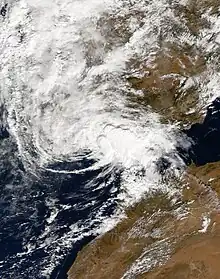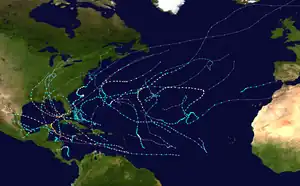 Vince near peak intensity southeast of the Azores on 9 October | |
| Meteorological history | |
|---|---|
| Formed | 8 October 2005 |
| Dissipated | 11 October 2005 |
| Category 1 hurricane | |
| 1-minute sustained (SSHWS/NWS) | |
| Highest winds | 75 mph (120 km/h) |
| Lowest pressure | 988 mbar (hPa); 29.18 inHg |
| Overall effects | |
| Fatalities | None reported |
| Damage | Minimal |
| Areas affected | Madeira Islands, Iberian Peninsula |
| IBTrACS | |
Part of the 2005 Atlantic hurricane season | |
Hurricane Vince was an unusual hurricane that developed in the northeastern Atlantic basin. Forming in October during the 2005 Atlantic hurricane season, it strengthened over waters thought to be too cold for tropical development. Vince was the twentieth named tropical cyclone and twelfth hurricane of the extremely active season.
Vince developed from an extratropical system on 8 October, becoming a subtropical storm southeast of the Azores. The United States National Hurricane Center (NHC) did not officially name the storm until the next day, shortly before Vince became a hurricane. The storm weakened at sea and made an extremely rare landfall on the Iberian Peninsula as a tropical depression on 11 October. Vince was one of only three tropical or subtropical cyclones to do so, alongside the 1842 Spanish hurricane and Subtropical Storm Alpha of 2020. It dissipated over Spain, bringing much-needed rain to the region, and its remnants passed into the Mediterranean Sea.
Meteorological history

Tropical storm (39–73 mph, 63–118 km/h)
Category 1 (74–95 mph, 119–153 km/h)
Category 2 (96–110 mph, 154–177 km/h)
Category 3 (111–129 mph, 178–208 km/h)
Category 4 (130–156 mph, 209–251 km/h)
Category 5 (≥157 mph, ≥252 km/h)
Unknown
On 5 October, an operationally unnamed subtropical storm which had gone unnoticed by the NHC was absorbed by a temperate frontal low, which was moving to the southeast over the Azores. The low pressure system gained a more concentrated circulation and lost its frontal structure after absorbing the subtropical storm. The developing system became a subtropical storm itself early on 8 October, 930 kilometres (580 mi) southeast of Lajes in the Azores.[1] However, the NHC decided not to name the system Vince at the time, because the water temperature was too low for normal development for a tropical cyclone. The storm gradually gained the tropical characteristics of symmetry and a warm inner core and became a tropical storm the next day. Its transformation to a tropical system occurred over water cooler than 24 °C (75 °F), much colder than the 26.5 °C (79.7 °F) usually required for tropical development.[1]
Soon after it became a tropical storm on 9 October near Madeira, with a ragged eye already present,[2] the NHC officially named it Tropical Storm Vince and began to issue advisories.[3] At the time there was some uncertainty as to whether Vince was tropical or subtropical but, in his post-season analysis, forecaster James L. Franklin of the NHC conceded that Vince had formed as a subtropical storm and had evolved into a tropical storm before it was named.[1] The storm's ragged eye quickly solidified and contracted into a "bona fide" eye with a diameter of 25 km (16 mi).[4] This increase in organization was accompanied by strengthening, and Vince reached its peak strength as a hurricane with 120 km/h (75 mph) winds later that day. The NHC forecasters decided that "if it looks like a hurricane, it probably is, despite its environment and unusual location".[4]

Hurricane Vince's impressive organization was very short lived as westerly wind shear began to erode the eye within hours.[5] In response, the storm weakened to a tropical storm shortly thereafter.[6] A broad low-level trough approached the storm from the northwest,[5] pulling the convection northward as the storm's low-level center accelerated eastward.[6][7] On 10 October, two brief bursts of convection surprised forecasters, but with the sea surface temperature as low as 22 °C (72 °F), the flares were not sustained.[8][9] Vince continued to weaken as it approached the Iberian Peninsula and became a tropical depression on 11 October, shortly before it made landfall near Huelva, Spain. The fast-moving tropical depression quickly dissipated over land.[1] Its remnants moved across southern Spain, dumping rain on the drought-ridden region, and moved into the Mediterranean Sea south of Alicante in the early hours of 12 October.[2]
Preparations and impact

The Spanish Center for Emergency Coordination declared a rain pre-emergency for the province of Castellón in the anticipation that Hurricane Vince would bring rains capable of flooding. The Instituto Nacional de Meteorología (INM) issued a bulletin that warned of a 40% chance of flooding. Four Spanish autonomous communities (Asturias, Catalonia, Castile and León, and Galicia) issued flood warnings, and Canarias issued a wind warning.[10] Spanish fishing fleets off the Andalusian coast returned to port and weathered the storm on their moorings rather than in the open ocean.[11]
Spain's population, which had been battling fires after a record breaking summer drought, welcomed the rains brought by Vince's remnants.[12] In two days the storm brought more rain to the province of A Coruña than had fallen all summer, easing the sinking water levels in provincial reservoirs,[11] but also causing traffic jams and minor floods.[13] In Córdoba province, the A-303, A-306 and CO-293 roads were partially flooded but "passable with caution". Municipal roadworks on La Ronda de Poniente, a major traffic artery connecting the city to nearby motorways, were flooded and partially destroyed.[14] The entrance of the University of A Coruña was temporarily blocked by flood waters on 11 October, and a nearby roundabout was submerged.[13] These damages were minor, and no fatalities were reported. The highest winds reported on land were 77 km/h (48 mph) at Jerez, Spain, although some ships recorded stronger.[15] Vince was comparable to normal rain events from temperate systems, with only 25 to 50 mm (1 to 2 in) of rain falling. Through a play on words of a song in the musical My Fair Lady, National Hurricane Center forecaster James Franklin in the Tropical Cyclone Report for Vince wrote, "the rain in Spain was mainly less than 2 inches [50 mm], although 3.30 inches [85 mm] fell in the plain at Córdoba."[1]
Records and naming

Subtropical Storm Vince formed in an unusual location in the far-eastern Atlantic,[16] and developed into a hurricane farther east than any other known storm at the time, at 18.9° W.[1] This record was broken by Hurricane Pablo in 2019, at 18.3° W.[17] The National Hurricane Center declared that Vince was the first tropical cyclone on record to have made landfall on the Iberian Peninsula.[1] Historical documents, however, suggest that a possibly stronger tropical storm or hurricane struck the Iberian Peninsula on 29 October 1842.
When Vince formed on 8 October it marked the first time in recorded history that a 21st tropical or subtropical storm had ever developed within a single Atlantic hurricane season. The previous record of 20 storms was set by the 1933 season.[18] Hurricane Vince was also the first named "V" storm in the Atlantic since naming began in 1950. It would be 15 years until another season would have a V-named storm – Tropical Storm Vicky in 2020 and also Tropical Storm Victor in 2021.[19] Tropical Storm Wilfred bested Vince as the earliest 21st named storm in a season, forming 20 days earlier.[20]
See also
- Other storms of the same name
- Timeline of the 2005 Atlantic hurricane season
- Tropical cyclone effects in Europe
- 1842 Madeira hurricane, made landfall in Spain
- Hurricane Ophelia (2017), easternmost Atlantic Basin major hurricane on record
- Hurricane Leslie (2018), extratropical remnant made landfall in Portugal
- Subtropical Storm Alpha (2020), made landfall in Portugal
References
- 1 2 3 4 5 6 7 James L. Franklin (22 February 2006). "Tropical Cyclone Report: Hurricane Vince" (PDF). National Hurricane Center. Retrieved 14 August 2011.
- 1 2 Staff (13 October 2005). "13 Oct 2005 ...'Hurricane Vince' visits southern Spain". Malaga Weather Channel. Archived from the original on 14 July 2011. Retrieved 14 August 2011.
- ↑ Richard Knabb (9 October 2005). "Tropical Storm Vince Discussion Number 1". National Hurricane Center. Retrieved 14 August 2011.
- 1 2 Richard Knabb (9 October 2005). "Hurricane Vince Discussion Number 2". National Hurricane Center. Retrieved 14 August 2011.
- 1 2 Richard Pasch (9 October 2005). "Hurricane Vince Discussion Number 3". National Hurricane Center. Retrieved 14 August 2011.
- 1 2 Franklin (14 August 2011). "Hurricane Vince Discussion Number 4". National Hurricane Center. Retrieved 30 July 2008.
- ↑ Richard Knabb (10 October 2005). "Hurricane Vince Discussion Number 5". National Hurricane Center. Retrieved 14 August 2011.
- ↑ Richard Knabb (10 October 2005). "Hurricane Vince Discussion Number 6". National Hurricane Center. Retrieved 14 August 2011.
- ↑ Stacy Stewart (10 October 2005). "Hurricane Vince Discussion Number 7". National Hurricane Center. Retrieved 14 August 2011.
- ↑ Staff Writer (12 October 2005). "Protección Civil alerta a cinco comunidades por la lluvia y el viento" (in Spanish). El Confidencial. Archived from the original on 21 November 2007. Retrieved 28 July 2008.
- 1 2 Javier Mesa (13 October 2005). "Las lluvias sólo frenan un 0,1% la pérdida de agua" (in Spanish). 20 minutos. Retrieved 28 July 2008.
- ↑ César-Javier Palacios (14 October 2005). "Fuentes sin agua" (in Spanish). 20 minutos. Archived from the original on 22 May 2011. Retrieved 28 July 2008.
- 1 2 Staff Writer (13 October 2005). "Llueve en sólo dos días más que en todo el verano" (in Spanish). 20 minutos. Retrieved 28 July 2008.
- ↑ Staff Writer (13 October 2005). "Problemas en varias carreteras de la provincia" (in Spanish). Diario Cordoba. Archived from the original on 16 September 2008. Retrieved 28 July 2008.
- ↑ "Consideraciones sobre el ciclón Vince: sus efectos sobre la península Ibérica" (PDF) (in Spanish). Ministerio de Medio Ambiente. Retrieved 28 August 2008.
- ↑ Knabb (9 October 2005). "Tropical Storm Vince Advisory Number 1". National Hurricane Center. Retrieved 11 October 2008.
- ↑ Stewart (27 October 2019). "Hurricane Pablo Advisory Number 8". National Hurricane Center. Retrieved 27 October 2019.
- ↑ Landsea, Christopher W.; Hagen, Andrew; Bredemeyer, William; Carrasco, Cristina; Glenn, David A.; Santiago, Adrian; Stratham-Sakoskie, Donna; Dickinson, Michael (15 August 2014). "A Reanalysis of the 1931–43 Atlantic Hurricane Database" (PDF). Journal of Climate. American Meteorological Society. 27 (16): 6093–6118. Bibcode:2014JCli...27.6093L. doi:10.1175/JCLI-D-13-00503.1. S2CID 1785238. Retrieved 1 November 2020.
- ↑ Alvarez-Wertz, Jane (14 September 2020). "Tropical Storm Vicky becomes 20th named storm of the 2020 season, 5 named storms currently in Atlantic". wavy.com. Portsmouth, Virginia: WAVY-TV. Retrieved 14 September 2020.
- ↑ Fox 13 News (18 September 2020). "Tropical Storm Wilfred forms in Atlantic, using final name on NHC's 2020 list". Tampa, Florida: WTVT. Retrieved 18 September 2020.
{{cite news}}: CS1 maint: numeric names: authors list (link)
